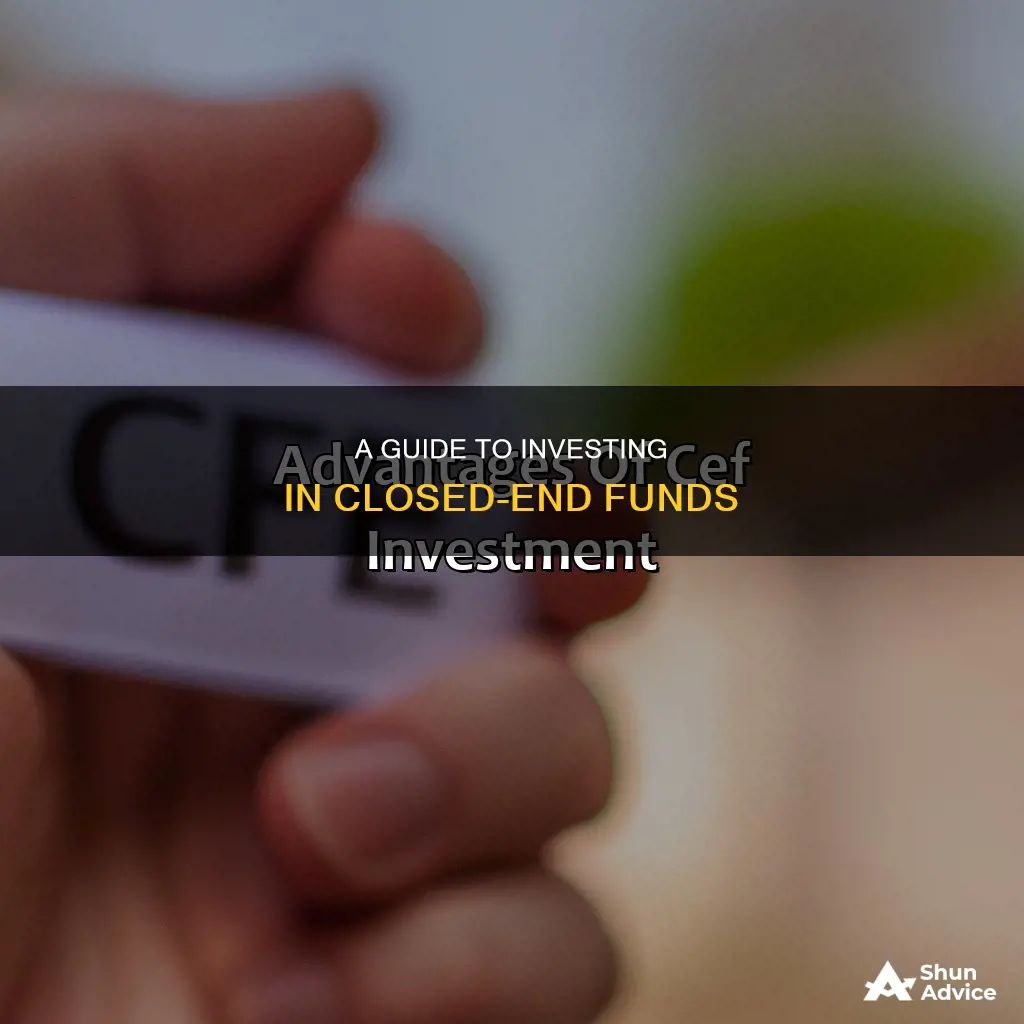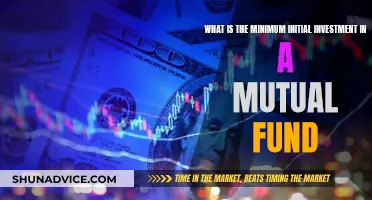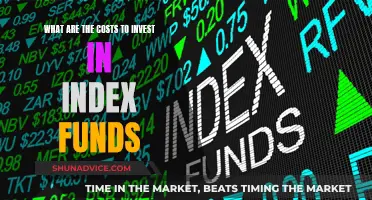
A closed-end fund is a type of mutual fund that issues a fixed number of shares through an initial public offering (IPO) to raise capital for its initial investments. Its shares can then be bought and sold on a stock exchange, but no new shares will be created, and no new money will flow into the fund. This is in contrast to an open-end fund, which accepts a constant flow of new investment capital and issues new shares accordingly.
Closed-end funds are actively managed and typically concentrate on a single industry, sector, or region. They are also similar to stocks and ETFs in that their shares fluctuate in price throughout the trading day.
When considering how to invest in a closed-end fund, it's important to understand the fund's strategy, fees, distribution rate, and leverage. It is also worth noting that closed-end funds tend to be more volatile than open-end funds due to their use of leverage and the fact that they can sell at a premium or discount to their net asset value.
| Characteristics | Values |
|---|---|
| Type of Fund | Mutual fund |
| Investment Strategy | Greater flexibility in the types of investment strategies used |
| Income and Return | Higher potential income and return |
| Liquidity | Intra-day liquidity |
| Shares | Fixed number of shares |
| Share Price | Determined by competitive bidding on the stock exchange |
| Net Asset Value | Value of all fund assets, less liabilities, divided by the number of shares outstanding |
| Trading Price | May trade at a premium or discount to NAV |
| Distribution Rate | Not guaranteed |
| Distribution Sources | Interest income, dividends, capital gains, or a combination of these types of payments |
| Tax Implications | Pass-through tax obligations to investors |
| Management | Actively managed by a manager overseeing the portfolio |
| Risks | More volatile than open-end funds, higher fees, use of leverage |
What You'll Learn

Understand the risks and rewards of the CEF's investments
Understanding the risks and rewards of CEFs is essential before investing in a closed-end fund. Here are some key points to consider:
Risks
Closed-end funds (CEFs) come with their own set of risks that investors should be aware of. One key risk is the valuation risk, where the market price of a CEF can vary significantly from its net asset value (NAV). This variation can impact an investor's return over time, and there is no guarantee that the size or duration of a discount or premium on the CEF's price will be limited.
Another risk is the market risk associated with the underlying securities held by the CEF. Even the best investment managers cannot avoid losing periods, and if the specific securities or sectors the CEF concentrates on decline in value, the CEF's value will also decrease.
Leverage risk is another important factor. Most CEFs use leverage to enhance returns, but this can also magnify losses. Industry regulations limit leverage usage, but some funds are more aggressive than others. Leverage typically comes in the form of bank loans or the issuance of preferred stock.
Liquidity risk is also a concern. Just because a CEF is listed on a stock exchange does not guarantee sufficient liquidity. Large trades relative to the fund's average daily volume could impact the market value.
Additionally, CEFs may invest a significant portion of their assets in illiquid securities, which can be challenging to value and may be impossible to sell. This can lead to increased volatility in the CEF's share price.
Other risks include the possibility of manager underperformance, equity securities risk, fixed-income securities risk, foreign investment risk, derivatives risk, and level dividend policy risk, where the manager may dip into capital gains or principal to maintain dividend payments.
Rewards
CEFs offer several potential benefits and rewards for investors. One key advantage is the potential for higher income and returns. CEFs can provide access to less liquid and private investments, potentially harvesting the illiquidity premium. Unlike private funds, CEFs do not charge performance fees.
Listed CEFs offer intra-day liquidity, and the term feature ensures NAV liquidity upon maturity. Some CEFs also offer quarterly liquidity and continuous subscriptions.
CEFs also provide diversification by allowing investors to access a wide range of asset classes, including stock funds, bond funds, and balanced funds, in both foreign and domestic markets.
Additionally, CEFs are actively managed, allowing investors to benefit from the fund manager's expertise and skills. This active management aims to deliver returns that exceed those of passive index-tracking products.
Furthermore, CEFs may offer a more stable pool of assets for the investment manager to work with, as there is no continuous creation of new shares or redemption of outstanding shares. This stability can eliminate liquidity strain due to sudden redemptions or new purchases.
In summary, while CEFs come with certain risks, they also offer potential rewards in the form of higher returns, diversification, active management, and access to less liquid investments. However, it is essential to carefully consider and understand the risks before investing in CEFs.
Best Banks for Investment: Where to Invest Your Money?
You may want to see also

Look for lower fees
Closed-end funds (CEFs) typically have higher fees than other funds. According to CEF Insider data, CEFs' average annual fees are 1.09% (or $109 for every $10,000 invested), though fees in the 3-4% range are not unusual. In contrast, Morningstar data shows that the asset-weighted average fee for mutual funds and exchange-traded funds (ETFs) in 2018 was just 0.48%.
When deciding which closed-end fund to invest in, it is important to look for lower fees. While CEFs deliver sky-high yields several times more than the average ETF yield, high fees can cost investors tens of thousands of dollars in returns and opportunity cost.
However, it is worth noting that CEFs that issue debt to achieve leverage must include the interest expense they pay on that debt in their expense ratios. This makes it difficult to compare CEFs with non-leveraged CEFs and mutual funds.
When looking at the expense ratio of a CEF, be aware of "unofficial" expense ratios. Less scrupulous fund executives may report several other expense ratios alongside the official expense ratio to make their fund look more appealing. Investors should ignore these "pro-forma expense ratios" and focus on the official expense ratio.
- Cohen & Steers Total Return Realty Fund (RFI)
- Nuveen S&P 500 Dynamic Overwrite Fund (SPXX)
- Tri-Continental Corporation (TY)
- Source Capital (SOR)
- BlackRock Enhanced Capital & Income Fund (CII)
- Adams Diversified Equity Fund (ADX)
- Putnam Managed Municipal Income Trust (PMM)
Bond Funds: Best Time to Invest and Why
You may want to see also

Check the fund's leverage
When considering investing in a closed-end fund, it is important to check the fund's leverage. Leverage is the use of debt to make investments and can be beneficial for companies and investors when used effectively. However, it is important to understand the risks associated with leverage.
Closed-end funds and mutual funds may use leverage to enhance their returns, which can magnify gains as well as losses. Leverage allows funds to borrow money to boost their returns to investors, leading to higher potential rewards during favourable market conditions. On the other hand, leverage can also amplify losses during unfavourable market conditions, resulting in higher potential risks.
When evaluating the leverage of a closed-end fund, it is important to consider the following:
- Debt-to-Equity Ratio: This ratio compares the total liabilities of the fund to its total shareholders' equity. A high debt-to-equity ratio indicates that the fund has been aggressive in financing its growth with debt, which can result in volatile earnings due to additional interest expenses.
- Equity Multiplier: This ratio measures the total assets of the fund relative to its total equity. A high equity multiplier indicates that the fund's assets are mostly funded with debt rather than equity.
- Degree of Financial Leverage: This ratio assesses the sensitivity of a fund's earnings per share to changes in its operating income due to fluctuations in its capital structure. A higher degree of financial leverage indicates that the fund's earnings are more volatile.
- Consumer Leverage Ratio: This ratio evaluates the level of consumer debt relative to disposable income. It is used in economic analysis and by policymakers to understand the financial health of consumers.
- Debt-to-Capital Ratio: This ratio assesses the financial structure of the fund by comparing its total debt to its total capital (total debt plus total shareholders' equity). A higher debt-to-capital ratio indicates a higher risk of default for the fund.
- Debt-to-EBITDA Leverage Ratio: This ratio measures the fund's ability to generate income and pay down debt before accounting for interest, taxes, depreciation, and amortization expenses. A higher ratio may indicate a higher probability of defaulting on issued debt.
By analysing these ratios, investors can gain a better understanding of the financial health and stability of a closed-end fund. It is important to compare the leverage ratios of the fund across the industry and with its past performance to identify any potential risks associated with its debt obligations.
Cemetery Finances: Where Do Their Investments Lie?
You may want to see also

Assess the fund's distribution sources
When assessing the fund's distribution sources, it is important to understand that closed-end funds can offer distribution rates as high as 7% or more. However, it is crucial to remember that a fund's distribution rate is not guaranteed and can fluctuate from one distribution period to the next. Therefore, before investing in a closed-end fund, it is essential to understand how these funds operate and the potential risks involved.
Closed-end funds are a type of investment company that pools money from investors to buy securities. They are similar to mutual funds in that they professionally manage portfolios of stocks, bonds, or other investments, including illiquid securities. However, unlike mutual funds, closed-end funds typically offer a fixed number of shares in an initial public offering (IPO) and do not continuously sell new shares or redeem outstanding shares. This means that when you invest in a closed-end fund IPO, you are likely to pay a premium as the fees and expenses are deducted from the capital raised.
The distribution rates of closed-end funds can come from various sources, including interest income, dividends, capital gains, or a combination of these types of payments. In some cases, distributions may also include a return of principal, also known as a return of capital, where the fund's assets are used to pay the distribution instead of income generated by the investments. It is important to note that closed-end funds that return capital can carry a higher level of risk as they erode the asset base available to generate income for distribution payments.
To make informed investment decisions, it is crucial to understand the fund's distribution sources and their potential risks. Closed-end funds that follow a managed distribution policy set a specific distribution rate regardless of the income generated by the fund, making it more likely that they will return capital to investors. Therefore, before investing, it is essential to find out if the fund follows this approach. Additionally, prospective investors should be aware that they do not have access to the tax forms and must wait for the fund's annual statement to discern its use of the return of capital.
By assessing the fund's distribution sources, investors can gain a deeper understanding of the fund's sustainability and potential risks. Distributions primarily from net investment income are generally considered safer, while those from capital gains or a return of capital may be less reliable and could indicate future distribution reductions. Therefore, it is crucial to look beyond the distribution rate and analyse the fund's underlying sources of income to make informed investment decisions.
Best Funds to Invest in NPS: Where to Start?
You may want to see also

Compare the fund's discount to its net asset value
When investing in a closed-end fund, it's important to compare the fund's discount to its net asset value (NAV). The NAV of a fund is calculated by taking the total value of the fund's assets, subtracting its liabilities, and then dividing that figure by the total number of shares outstanding. Closed-end funds can trade at either a premium or a discount to their NAV. A premium means the fund's market price is higher than its NAV, while a discount means the market price is lower than the NAV.
Most closed-end funds have historically traded at a discount to their NAV. This means that the market price of the fund is lower than the value of the underlying assets. There are several reasons why a fund might trade at a discount. For example, a history of underperformance or volatility may make investors wary of the fund, driving down its share value. A bearish outlook on the securities in a fund can also lead to a discount. Additionally, closed-end funds do not have the same mechanisms as exchange-traded funds (ETFs) to manage deviations from their NAV, so they tend to trade with higher volatility.
On the other hand, a fund might trade at a premium due to high demand or positive investor sentiment. For instance, if a fund is focused on a sector currently popular with investors or its manager is well-regarded, it may trade at a premium.
It's important to note that the relationship between a fund's market price and its NAV can fluctuate. Just because a fund is currently trading at a discount does not mean it will always do so. Shifts in investor sentiment, demand, fund performance, distribution levels, market conditions, and fund-specific characteristics can all influence whether a fund trades at a premium or a discount.
When considering an investment in a closed-end fund, it's crucial to analyse the reasons behind any premium or discount. While discounts may present buying opportunities, it's important to carefully evaluate the fund's long-term prospects, sustainability of distributions, and overall performance.
Invest in Fidelity: New Millennium Fund for Future Growth
You may want to see also
Frequently asked questions
A closed-end fund is a type of investment company that pools money from investors to buy securities. They are similar to mutual funds but differ in that closed-end funds offer a fixed number of shares in an initial public offering (IPO) and do not continuously sell new shares or redeem outstanding ones.
Closed-end funds are actively managed by investment firms, which oversee the fund's portfolio and buy, sell, and hold assets. They invest in a basket of securities, including stocks, bonds, and other investments. Closed-end funds trade on stock exchanges throughout the trading day, and their share prices fluctuate based on supply and demand.
Closed-end funds offer several potential advantages. They provide access to less liquid and private investments, potentially resulting in higher income and returns. They also offer intra-day liquidity and can provide higher overall returns than open-end mutual funds due to their ability to use leverage and lack of need for a large cash reserve. Additionally, closed-end funds can offer consistent and predictable distributions, making them attractive to investors seeking regular income.
Closed-end funds have higher fees and tend to use leverage, which can magnify gains and losses. They are subject to volatility and are generally less liquid than open-end funds. They may also trade at a discount or premium to their net asset value (NAV), impacting the total return on investment.
You can purchase closed-end funds through a brokerage account. When considering a closed-end fund, it is essential to understand its investment strategy, fees, leverage, distribution rate, and whether it is trading at a discount or premium to its NAV.







